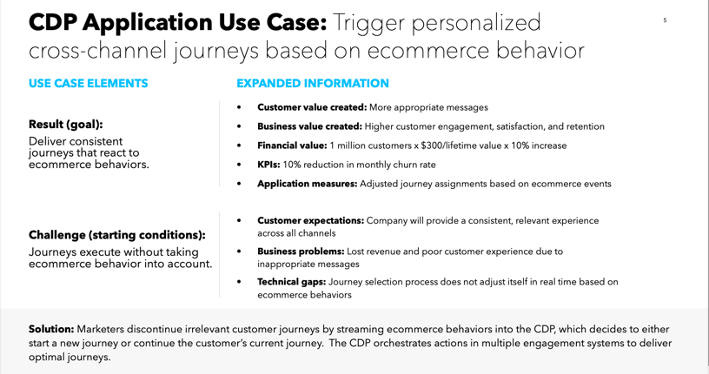
Stop Relying on Generic CDP Use Cases—How to Create Your Own
Evaluating customer data platforms (CDPs) is no simple task.
Getting it right starts with defining the right use cases.
Customer data platform use cases are critical for generating the system requirements you’ll need as you review each option. They’re also key in developing a successful deployment plan.
But most content about CDP use cases only offers a list of common and/or hypothetical cases. For example:
- Unifying your customer data
- Defining audience segments
- Creating personalization experiences
- Mapping the customer journey
- Driving cross sell and upsell
The use cases you find elsewhere online might be detailed enough to generate requirements and deployment plans, but they probably don’t reflect your company’s actual needs.
And the typical result is choosing the wrong system (and/or creating an unrealistic deployment plan).
Successful CDP projects are predicated on use cases defined by your business users who will execute them — here’s how.
Engage Your CDP Users
Your colleagues will probably only engage in your CDP project if they understand its value. Therefore, the first step is to make sure they have a basic understanding of what a CDP is, how it differs from existing systems, and how the CDP can help them achieve their business goals.
Related content: 2024 Customer Data Platforms—What You Actually Need to Know
Workshop Customer Data Platform Use Cases
With a solid overview under their belts, the next step is to help your users create their own list of CDP use cases — specific to your business, data sources, challenges, etc. One of the best ways to facilitate this process is by hosting a workshop. Ideally, your workshop moderator and company should have a general understanding of CDP technology.
Begin the session with a brief overview of CDP capabilities (again), as well as a rundown of the possible data sources you may wish to integrate into a single customer profile, such as:
- Website and app data
- Purchase data
- CRM data
- Customer service data
- Point-of-sale (POS) data
Next, encourage your colleagues to outline the important problems they would like to solve. For example:
- Increase product warranty renewals
- Recommend products and content based on individual behavior
- Highlighting travel add-ons and amenities based on preferences
With the problem list in hand, workshop participants should explore potential solutions for each through a use case analysis.
This discussion should include defining the goal, problem, a general description of the solution, and an outline of the key steps to achieve it. It’s critical to also list the data sources and processes involved within each step.
The analysis doesn’t need to be highly detailed, but it should offer sufficient information to determine if a CDP can address the problem — and whether the necessary data, system, and staff resources outside of the CDP are available. This understanding will be the core of subsequent planning.
Document Detailed CDP Use Cases
There are multiple CDP use case templates out there to help you with completing this task, but we prefer to use one from the CDP Institute. It includes the following elements.
1. Use case goals
Identify the use case goal, challenge, and solution in general terms. This is a task for business users.
2. Sequence actions
Define the sequence of actions required to execute the use case. This is primarily a task for business users, although they may need some technical support.
3. Value measures
Define the value measures, KPIs, application measures, and challenges in terms of customer expectations, business problems, technology, and final technical state. Business users and technical staff should cooperate on this and subsequent steps.
4. Detail each action
Define the details for each action, including external systems, data inputs, process details, outputs, and user skills and departments. This creates the basis for detailed requirements, which will be prepared primarily by technical staff.
5. Identify gaps
List any gaps that must be filled to execute the use case based on the current state of the company’s systems. In practice, some of those gaps may have already been closed by executing other use cases before this use case is added. Having a complete gap list for each use case helps to define the most effective sequence.
Once you’ve completed this process, you have a detailed understanding of the use case requirements. Business users must nurture the process to ensure the final product matches their actual needs.
Example CDP Use Case
Let’s say your users identify a use case for triggering cross-channel journeys based on ecommerce behavior. After collecting all of the required use case details in your workshop session, you would document those details as follows:
- Result (goal): Deliver consistent journeys that react to ecommerce behaviors.
- Challenge (starting conditions): Journeys execute without taking ecommerce behavior into account.
- Solution: Marketers discontinue irrelevant customer journeys by streaming ecommerce behaviors into the CDP, which either decides to start a new journey or continue the customer’s current journey. The CDP orchestrates actions in multiple engagement systems to deliver optimal journeys.
Additional details would include:
- Customer value created: More appropriate nmessages
- Business value created: Higher customer engagement, satisfaction, and retention
- Financial value: 1 million customers x $300/lifetime value x 10% increase
- KPIs: 10% reduction in monthly churn rate
- Application measures: Adjusted journey assignments based on ecommerce events
- Customer expectations: Company will provide a consistent, relevant experience across all channels
- Business problems: Lost revenue and poor customer experience due to inappropriate messages
- Technical gaps: Journey selection process does not adjust itself in real time based on ecommerce behaviors

It’s important that each use case clearly documents sequence actions in explicit detail. The details of our ecommerce behavior use case may look like this:

Beyond the Use Cases: Next Steps
Once you have clearly defined CDP use cases, the next step is to transform them into specific requirements. This is a complex task that requires a deep understanding of both the business and the technology — so be sure to involve people with experience in CDPs or related systems.
But it’s crucial for business users to stay involved, too, as you create requirements and evaluate CDPs. Keeping your colleagues in the loop will ensure that your selection process continues to reflect their actual needs.
Get the CDP RFP Right, Too
Eventually, you’ll probably issue an RFP for your CDP project — but don’t do it before you have clear use cases and requirements! This will only set you up for headaches down the road when you evaluate your options against extraneous factors.
Requirements in hand?
Learn more about running a successful CDP RFP: Getting the Best Customer Data Platform Starts with the Right RFP
Want to see Zeta in action?



